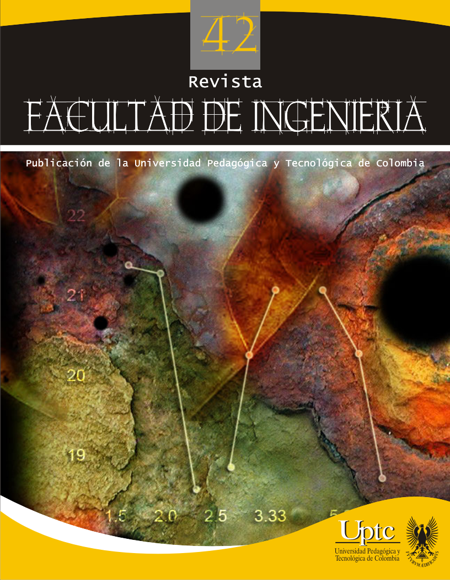Comparative study of fluid flow across orifice plate using Stokes and Navier-Stokes equations

Abstract
This paper presents the results of a comparison between Stokes and Navier-Stokes equations, in order to simulate the flow of liquid water at atmosferic conditions, through a concentric orifice plate. From experimental data taken from the fluids bank, the simulations of both equations were evaluated, using free software Freefem++CS, which is based on the finite elements method. The evaluated variables are velocity and pression in a time interval. When analyzing the results obtained with the simulations and comparing them with the experimental data, it was found that the Navier-Stokes equations represent better the system, than the Stokes equation.
Keywords
mathematical model, orifice plate, simulation, Stokes and Navier-Stokes equations
References
- J. M. Cimbala and Y. A. Cengel, “Flujo en Tuberías”, Mecánica de Fluidos: Fundamentos y Aplicaciones. V.C. Olguin. Mexico: McGraw Hill, pp. 321-398, 2006.
- R. L. Mott, “Medición del Flujo”, Mecánica de Fluidos. J. E. Brito. Mexico: Pearson Education, pp. 473-499, 2006.
- B. Manshoor, F. C. Nicolleau and S. B. Beck, “The fractal flow conditioner for orifIce plate flow meters”, Flow Measurement and Instrumentation, vol. 22 (3), pp. 208-214, Jun. 2011. DOI: http://dx.doi.org/10.1016/j.flowmeasinst.2011.02.003. DOI: https://doi.org/10.1016/j.flowmeasinst.2011.02.003
- J. Banks, J. S. Carson, B. L. Nelson and D. M. Nicol, Discrete-event system simulation. USA: Prentice Hall, 2009.
- F. Hecht, O. Piro and A. Le Hyaric, “Freefem++,” 2014. [Online]. Disponible: http://www.freefem.org/ff++/ftp/freefem++doc.pdf.
- R. Lewandowski, “The mathematical analysis of the coupling of a turbulent kinetic energy equation to the Navier-Stokes equation with an eddy viscosity”, Nonlinear Analysis, Theory, Methods & Applications, vol. 28 (2), pp. 393-417, Jan. 1997. DOI: http://dx.doi.org/10.1016/0362-546X(95)00149-P. DOI: https://doi.org/10.1016/0362-546X(95)00149-P
- M. M. Rhaman and K. M. Helal, “Numerical Simulations of unsteady Navier-Stokes Equations for incompressionable newtonian fluid using FreeFem++ based on Finite Element Method”, Annals of Pure and Applied Mathematics, vol. 6 (1), pp. 70-84, May. 2014.
- C. L. Felter, J. H. Walther and C. Henriksen, “Moving least squares simulation of free surface flows”, Computers & Fluids, vol. 91, pp. 47-56, Mar. 2014. DOI: http://dx.doi.org/10.1016/j.compfluid.2013.12.006. DOI: https://doi.org/10.1016/j.compfluid.2013.12.006
- Z. Li, K. Ito and M. C. Lai, “An augmented approach for Stokes equations with a discontinuous viscosity and singular forces”, Computers & Fluids, vol. 36 (3), pp. 622-635, Mar. 2007. DOI: http://dx.doi.org/10.1016/j.compfluid.2006.03.003. DOI: https://doi.org/10.1016/j.compfluid.2006.03.003
- T. Geenen, M. ur Rehman, S. P. MacLachlan et al., “Scalable robust solvers for unstructured FE geodynamic modeling applications: Solving the Stokes equation for models with large localized viscosity contrasts”, Geochemistry, Geophysics, Geosystems. An Electronical Journal of the earth sciences, vol. 10 (9), pp. 1-12, Sep. 2009. DOI: https://doi.org/10.1029/2009GC002526
- A. Mojtabi and M. O. Deville, “One-dimensional linear advection–diffusion equation: Analytical and finite element solutions”, Computers & Fluids, vol. 107, pp. 189-195, Jan. 2015. DOI: http://dx.doi.org/10.1016/j.compfluid.2014.11.006. DOI: https://doi.org/10.1016/j.compfluid.2014.11.006
- J. Volker, K. Kaiser and J. Novo, “Finite Element Methods for the Incompressible Stokes Equations with Variable Viscosity”, Zeitschrift fûr Angewandte Mathematik und Mechanik, vol. 96 (2), pp. 205-216, 2016. DOI: http://dx.doi.org/10.1002/zamm.201400291. DOI: https://doi.org/10.1002/zamm.201400291
- P. Gómez-Palacio, “Solución de la ecuación de Stokes”, Revista Universidad EAFIT, vol. 46, pp. 90-102, 2010.
- E. Engineering, Análisis y Simulación de la dinámica de fluidos computacionales-CFD a fluidos internos [Online]. Disponible: http://evaeng.com/analisis-y-simulacion-de-ladinamica-de-los-fluidos-computacionales-cfda-flujos-internos/.
- C. M. Institute, Navier-Stokes equation [Online]. Disponible: http://www.claymath.org/millennium-problems/navier%E2%80%93stokes-equation.
- J. L. Vázquez, Fundamentos matemáticos de la mecánica de fluidos. Madrid: Universidad Autónoma de Madrid, 2003.
- P. K. Kundu, I. M. Cohen and D. R. Dowling, Fluids Mechanics. Elsevier, 2012.